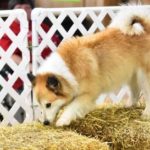The Barn Hunt Buzz
By now you have probably heard rumors of a “new” dog sport sweeping the nation - involving barns, straw, rats and PVC tubes. With THAT combination, most people are immediately intrigued. Does Barn Hunt use wild rats? Are the rats scared? Do the dogs hurt the rats? This article shall explain what Barn Hunt is and is not, how it came to be and why you should give it a try with your dog!
Barn Hunt is the fastest growing dog sport to hit North America and is growing in leaps and bounds - daily. It is really no wonder - it is great fun for people and dogs! It takes a dog’s natural instinct to find quarry, builds in a requirement of teamwork and offers plenty of challenge and strategy for both dog and human!
“Barn Hunts” are not new in concept. Built on the age old canine job of vermin hunting, barn hunts were developed to showcase ratting instinct without risk to people, dogs or rats. Barn Hunts were often a side event to some Earthdog and Terrier trials, and were purely for fun or as a special attraction. Enter Robin Nuttall - the founder of Barn Hunt Association or BHA, Inc. Robin has Doberman Pinschers and Miniature Pinschers, and has tried for years to have her Min Pins allowed in AKC Earthdog events. AKC denied the initial requests so Robin took the sport she had seen at terrier trials (Barn Hunt) and created the venue “formally” so her Min Pins could employ their instincts. Robin left the event open to all breeds regardless of size and so begins the craze…
Barn Hunt is open to all breeds and mixes, age six months and up as long as they can safely navigate a course and fit through an 18” wide tunnel that is about 22” tall. Deaf and three legged dogs can participate, too. The venue is excellent for retired older dogs, people and dogs that have physical limitations and for anyone looking to enjoy a mock hunt in a fun environment. While overall the sport can be less demanding on teams, upper levels can be a very active and demanding sport. Runs are timed and can be QUITE challenging and competitive for human and dog alike.
For those that enjoy a good healthy competition…Barn Hunt offers titles from the instinct certificate (RATI) all the way up to a Championship (RATCH) with lots of titles in between.
The Rats
The rats used in Barn Hunt are domesticated pet rats and are fully contained in a 4” diameter PVC tube with lots and lots of ventilation holes. Rat safety is of primary concern and rats are swapped out and given breaks frequently. Rat safety rules include prevention of rolling, skittering and picking up tubes. Dogs NEVER come in direct contact with the rats and rats are never, ever outside the tubes at sanctioned events.
Most clubs have their own rats which are raised specifically for this event. My rats are bred for their outgoing nature and are clicker trained to the barn hunt tubes when they are four weeks old. Once they are eagerly entering the tubes by choice, they are slowly incorporated into the program. Fearful rats (although very rare in my experience) are not included in my program. Experienced “tube” rats will often compete to be the first one in the tube and mine “self-load” because they enjoy the adventure. There are many stories across the country of barn hunt rats that seem to revel in messing with the dogs!
In addition to the ever-important “RAT TUBE”, there are two additional and identical PVC tubes out there on each course to add to the challenge. One tube contains nothing (called the “EMPTY TUBE”) and the other contains a cup of bedding/litter which the rat slept on the night before (called the “LITTER TUBE”). As dogs graduate into the next levels they are challenged with an increasing number of tubes and a change in the ratio of empty to litter to rat tubes.
Judging is based on the handler calling the rat tube(s) to the judge based on observing their dog’s behavior. As long as the handler can read the dog, the team can be successful. Once the rat is confirmed by the judge, the tube can be left in play or removed - it’s the handlers call. If the call was incorrect, the run ends as a NQ. Other NQ’s include overtime, touching bales/tubes or dogs, elimination in the ring, and inability to get a climb or a tunnel.
What is exciting about barn hunt is that most dogs can be very successful and enter a trial with little to no practice! As the team becomes more experienced, the courses get more challenging and strategy can come into play. People love this sport because it is a finely balances game of instinct, teamwork, strategy and luck … the elements of any good game!
The Levels
Most dogs generally start at the INSTINCT level- which is the ONLY specified BH course layout. The “Instinct Fork”, as it is sometimes called, is laid out with the three tube types (empty, litter, rat) sitting out in the open. Teams leave a start box and head to the tubes. If they call the correct rat tube within one minute, they get a RATI title! Instinct is NOT a prerequisite for Novice, so you can enter Instinct AND Novice at any trial. Once you finish the RATN title, you can’t go back to Instinct.
The first “titling” level is the NOVICE level and is a course developed by the judge - just like an agility course. Teams need to identify the correct rat tube of the three (1 litter, 1 empty and 1 rat) as in Instinct … except NOW the three tubes are hidden amongst up to 30 bales of straw. In addition to the handler calling ONLY the rat tube, the dog must complete a tunnel and climb on the bales in 2 minutes. Three passes at Novice earns the RATN title.
It is at the Novice level that the courses can get really fun. A judge’s personality and creativity come out as they build memorable courses that can be a challenge! As a class is being run at a hunt…the course (straw layout) stays the same but the hides change. Each of the tubes move around between what are called “blinds”.
A blind is a group of five dog/handler teams together in an area called a “blind”. This blinding area prevents handlers from knowing where the tubes are hidden on the course. The blind is sometimes a pop up tent with sides or a room off to the side. The most important thing about a blind is that the dog and handler cannot see the hide locations. The same tube locations will be used for all dogs in that blind group. Once the blind is assembled and all five teams are in the blind area, the judge will set his/her tube locations. Each team will run, one at a time, until everyone has completed their run. Once everyone has run out, a new blind is assembled and new tube hiding spots are planted.
Barn Hunt does a fantastic job of understanding that dogs may not get along with other dogs, so no dog can be within 20 feet of the ring of a competing dog. Even in the blinds, you are allowed to have treats to keep your dog calm before they go to the ring. Toys and treats must be cleared out prior to competing because no toys or treats are allowed in the ring, but they are allowed prior.
Levels such as OPEN (two rats) and SENIOR (four rats) have multiple numbers of all the different tube types. The quantity of bales on course gets bigger, the courses gets taller and the tunnels get deeper!
The highest level is MASTERS and five passes earns the RATM. Continued passes in masters beyond the RATM can earn the coveted Barn Hunt Championship or RATCH.
The difficulty and level of precision needed makes getting a RATCH a great honor. AKC also has partnered with BHA to allow for Barn Hunt titles to be reflected on AKC registrations, so you may be seeing a RAT title on the pedigree dogs in AKC events!
Herding Breeds
While one may think that Barn Hunt was custom designed for terriers, many breeds from herding excel at the event. Herding dogs hit the sport by storm and are quickly moving up the ranks. At the time of this writing, the highest title in Barn Hunt is a RATCH 13 (that’s 145 PASSES at Master) and is owned by a German Shepherd Dog!
Herding dogs took top honors at the 2015 Barn Hunt National, hosted by Purina Farms in St Louis. Four of the medals - one gold, one silver and two bronze (one of which was a two herding dog tie) - were earned by herding breed dogs. Barn Hunt and herding breeds are a great combination!
Questions about getting into Barn Hunt? Go to barnhunt.com for rules and event information.
Want to see what it looks like? Search YouTube for Barn Hunt videos … plenty of examples are out there OR find an event close to you!
In my next article, I will share some experiences and strategy with you as well as some insights into starting and competing with a herding dog in barn hunt. Until then, happy hunting!
Article By:
Eva Raczka
___________________________________________________________________________________
Eva Raczka has been involved in dog sports since 8 years of age. She has trained and titled dogs in Obedience, Rally, Agility, Herding, Retriever Hunt Tests and more and utilizes her diverse training in teaching barn hunt and developing drills to proof and develop teams. Barn Hunt is her passion and she has introduced over 500 dogs and their owners to Barn Hunt through seminars, classes, lessons and more. Eva has won high scoring awards at every class level of Barn Hunt as well as being an A level Barn Hunt Judge. Eva and her Belgian Tervuren “Pi” (in addition to being the first RATCH X Terv) were Gold Medalists in Versatility and Bronze Medalists in Games at the 2015 BHA National earning the coveted Grand National Champion status.






